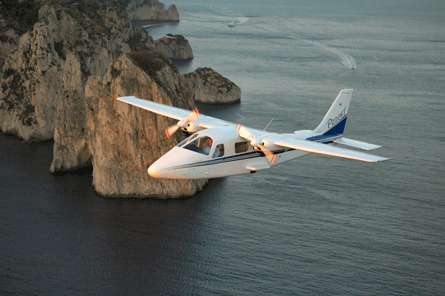Italian aircraft designers will have a gift ready for the US market when the AirVenture 2009 show opens at Oshkosh next week - a four-seat, twin-engine aircraft moulded from Tecnam's popular easy-to-fly, all-metal, factory-built light sport aircraft (LSA).
The Tecnam P2006T has the same automotive fuel-burning Rotax engines, gearboxes and aluminium wing structures as Tecnam's LSAs, but will be certificated under Part 23 and so be available for broader missions.
It was certificated in Europe in May and is causing a buzz in the US, says Lynne Birmingham, Georgia-based US sales representative for Tecnam.
"We're seeing a lot of requests from the air taxi industry," says Birmingham. Many of those inquiries are coming from operators of single-engine Cirrus aircraft who want a low-cost twin-engine aircraft. Pricewise, a P2006T is similar to a high-end Cirrus - well equipped, with options including a Garmin glass panel, for about $500,000.
But in terms of performance, the Rotax 912S-powered aircraft is unlike most, if not all, Part 23 twins.
 |
|---|
© TecnamTecnam says its P2006T has attracted interest from the air taxi industry and flight schools |
Tecnam says the geared 100hp (73kW) Rotax engines for the P2006T weigh only 64kg (140lb) each and have a frontal area of 0.15m2 (1.6ft2), compared with 146kg and 0.4m2 for the Lycoming O-360 180hp engine that powers the four-seat Diamond DA42 twin, a direct competitor for the new model.
Birmingham says FAA validation is expected "in the next couple of months".
Tecnam, which imports about 40 LSAs a year into the USA, where it has a 6% market share with about 120 aircraft distributed so far, says larger, college-based flight schools are interested in the P2006T.
German LSA manufacturer Flight Design, maker of the carbonfibre CT LSA and all-metal MC model, is also seeing more interest from flight schools. "Some kind of sea-change has happened," says Tom Peghiny, president of Flight Design USA.
"Historically, the primary market for the LSA was private aircraft owners seeking refuge from their FAA medical. Now more people are looking for new technology and a cheaper way to fly, and we're more active with flight schools."
Peghiny says the change is partly due to the ability to fuel the aircraft with lower-cost automobile gasoline, but also to an increase in students wanting sport pilot training.
At Oshkosh, Flight Design will bring its first production all-metal MC model LSA to the US market as the prize in an Experimental Aircraft Association (EAA) raffle.
The company will also show a German-made hybrid engine concept - a 40kW electric motor combined with a Rotax 914 engine. Because of its weight, this design would be for a four-seat aircraft.
Operationally, such an aircraft would use engine and electric power for maximum thrust on take-off, and engine power only for cruise, says Peghiny.
The company has worked on the design for a four-seater, but is not actively developing it, he adds.
Flight Design is the best-selling manufacturer in the US market for factory-built LSAs, having delivered 300 CT aircraft.
Peghiny says sales this year will be down about 30% on last year, which itself was down from a high of 100 deliveries in 2007.
Despite the drop, Peghiny points out that US distribution has remained "slow but sustainable" throughout the economic crisis.
Source: Flight International



















